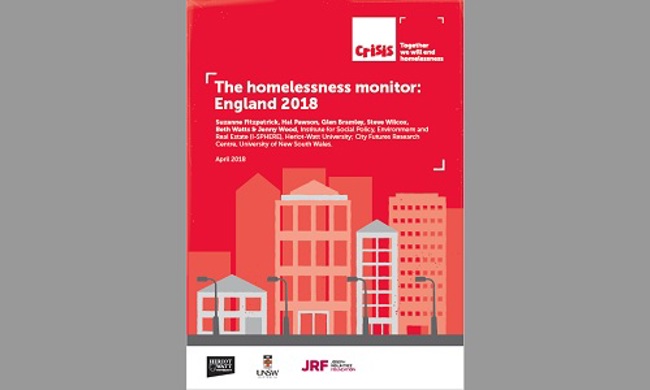The Homelessness Monitor: England 2018
12.04.2018
The Homelessness Monitor: England 2018 is the seventh annual report of an independent study, commissioned by Crisis and funded by Crisis and the Joseph Rowntree Foundation, of the homelessness impacts of recent economic and policy developments in England.
Key findings
- Homelessness has shot up the media and political agenda over the past year. All of the major party manifestos made mention of homelessness in the snap June 2017 election, and the Conservatives under Theresa May pledged to halve rough sleeping by 2022 and eliminate it altogether by 2027. The Prime Minister has also established a high-level Rough Sleeping and Homelessness Reduction Taskforce supported by an expert Rough Sleeping Advisory Panel.
- This political attention is in large part a response to the ongoing rise in officially estimated rough sleeper numbers, with the national total now up by 169 per cent since 2010. The more robust statistics routinely collected by the CHAIN system similarly show London rough sleeping having more than doubled since 2010. Latest figures show London rough sleeping involving UK nationals continuing to increase very slightly. However, thanks to a sharp contraction in street homelessness involving those of Central and Eastern European and other non-UK origin, overall London rough sleeping has marginally reduced since 2015.
- At just over 59,000, annual homelessness acceptances were some 19,000 higher across England in 2016/17 than in 2009/10. With a rise of 2 per cent over the past year, acceptances now stand 48 per cent above their 2009/10 low point. However, administrative changes mean that these official statistics understate the true increase in ‘homelessness expressed demand’ over recent years.
- Since bottoming out in 2010/11, homeless placements in temporary accommodation have risen sharply, at twice the rate of homelessness acceptances. Thus, the overall national total rose by 8 per cent in the year to 31 March 2017, up 61 per cent on the low point six years earlier. A continuation of this trend would see placements topping 100,000 by 2020. Though accounting for only 9 per cent of the national total, bed and breakfast placements have been rising particularly quickly, and now stand 250 per cent higher than in 2009. The National Audit Office has drawn attention to a 39 per cent real terms increase in local authority spending on temporary accommodation in the five years to 2015/16, a period when expenditure on homelessness prevention declined.
- All available evidence points to Local Housing Allowance reforms as a major driver of this association between loss of private tenancies and homelessness. These reforms have also demonstrably restricted lower-income households’ access to the private rented sector. The number of Housing Benefit/Universal Credit claimants who are private tenants is now some 5 per cent lower than when the Local Housing Allowance reforms began in 2011, despite the continuing strong growth of the private rented sector overall. This policy has also, as intended, had a particularly marked impact in inner London.
- Alongside the narrowing opportunities to access the private rented sector (see above), there is a growing evidence of a squeeze on homeless households’ access to social tenancies. This arises not only from the pressure on the highly diminished pool of available social rented properties, with an 11 per cent drop in new lettings in the past year alone, but also a reported increase in social landlord anxieties about letting to benefit-reliant households and those with complex needs.
- The Homelessness Reduction Act 2017, due to come into force in April 2018, seems to have garnered significant and growing cross-sectoral support. While there remain concerns regarding the adequacy of the ‘new burdens’ funding granted to local authorities to support the Act’s implementation, the more fundamental issues relate to the growing structural difficulties that many local authorities face in securing affordable housing for their homeless applicants.
Research
Fitzpatrick,S., Pawson, H., Bramley, G., Wilcox, S., Watts, B. & Wood, J. (2018) The Homelessness Monitor: England 2018, London: Crisis.


